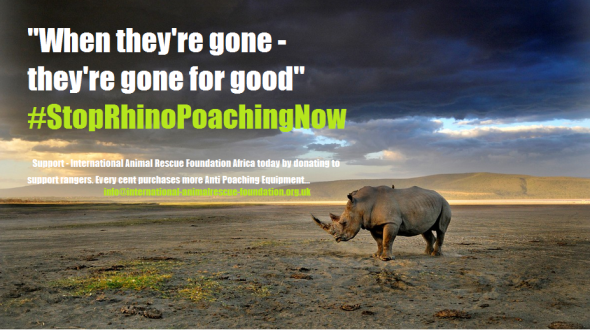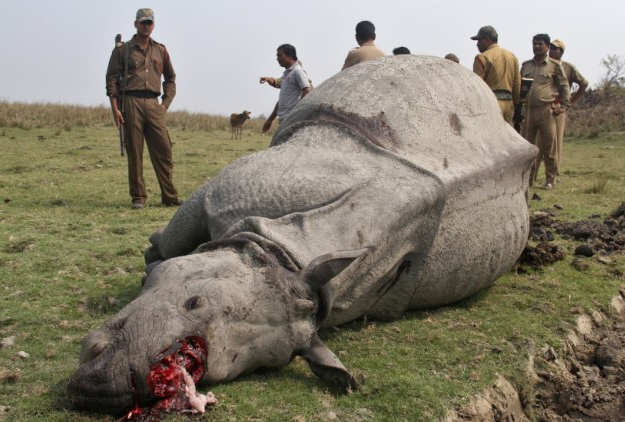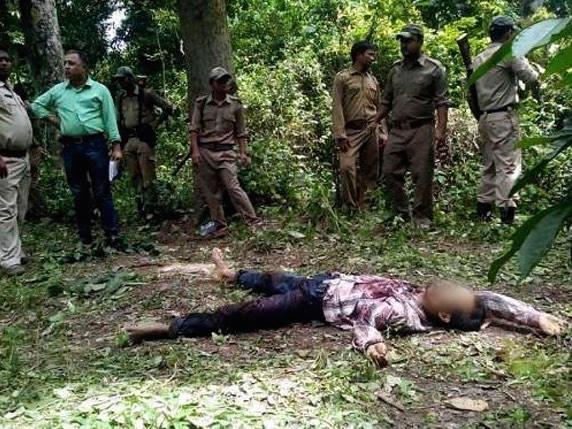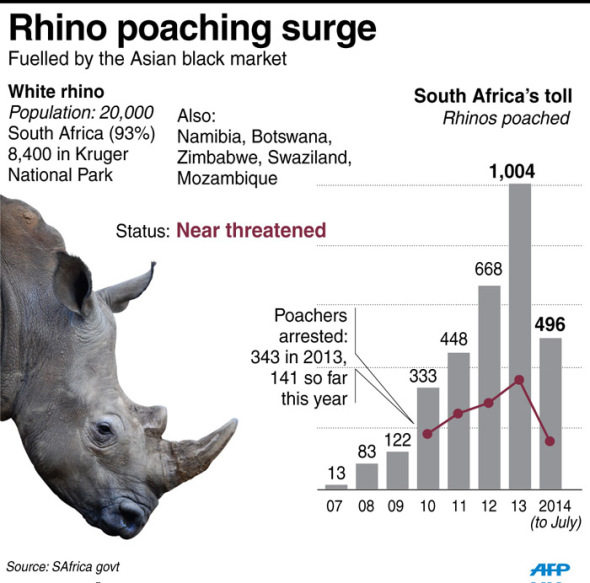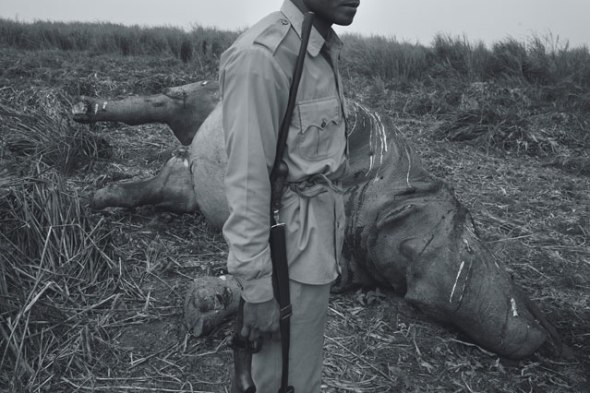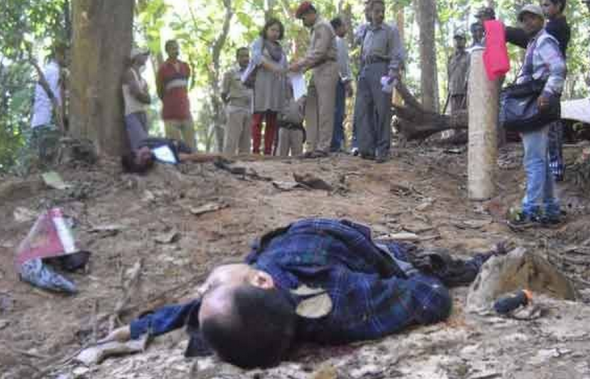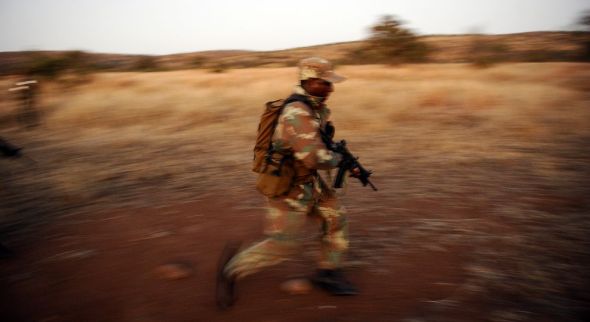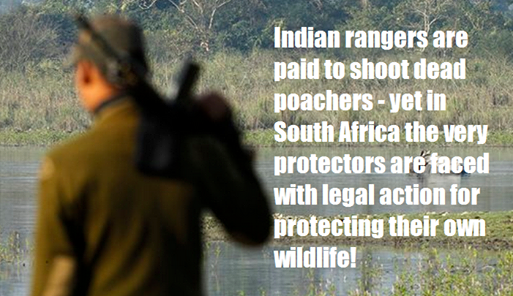India: War on Poaching Intensifies.
India: War on Poaching intensifies.
Since early May 2012 the Indian State, Maharashtra government provided all of its rangers a shoot to kill licence directly aimed at “poachers” regardless of age, sex or religion. The shoot to kill order was given of which rangers are immune from prosecution due to high levels of Rhino, Tiger, Lion and, Elephant poaching within the country.
When International Animal Rescue Foundation India became aware of Maharashtra government’s demands they watched and waited for results of which back then were little however, since 2013 rangers have been actively involved in over one hundred and forty nine legal killings with a further eleven so far to date (13th June 2015). The number is believed to be a lot higher. Furthermore as poaching is not just confined to “animals” but also the sacred sandalwood, forestry rangers have been actively engaging sandalwood poachers and smugglers too.
April 4th 2015 forestry rangers and Police came under heavy gunfire in two separate locations within Tamil Nadu, Chittoor. Police and forestry guards tried to apprehend some twenty sandalwood poachers/smugglers of which took off into the sandalwood forests in Andhra Pradesh. The first shoot out saw some saw some nine smugglers shot dead in one area of the sandalwood forest that is unknown to us while a second saw a further eleven smugglers shot dead in what was described as a “heavy exchange” of bullets from both sides within Chittoor in Southern Andhra Pradesh. While some people have stated this action unjust we please ask you to continue to reading (to the bottom) for you to fully understand why the Police and forestry services may have took such action.
2015 has been quite a busy year thus far for forestry rangers and Police. At the start of the year, 15th January 2015 three Rhino poachers that were directly ordered to lay down their weapons aimed them at forestry guards opening fire. The incident that took place in the Kaziranga National Park, in the remote state of Assam prompted forestry guards to act quickly and professionally to preserve the sacred One Horned Rhino of which they shot the three poachers dead instantly. Fortunately no forestry guards or the Rhino were injured this time.
March 2015 a further three ivory poachers that were caught red handed slaughtering an Indian Rhino of which the Indian Rhino lost its life and was left in a pitiful state were shot dead immediately. We’ve included the image of that Rhino below for your information and to grasp why we and India have now had enough of this slaughter and will take the relevant steps required to support our men and women to secure our fauna and flora.
Image: Rhino killed by ivory poachers - poachers shot dead on site.
While poaching continues so does “hunting the poachers too” and so it rightfully should. International Animal Rescue Foundation India supported by its sister Africans Environmental company, began paying five “unnamed” forestry units within the shoot to kill zones larger cash incentives to hunt and take down any mammal or sandalwood poachers. The organisation has come under some fierce criticism from mainly European and American citizens most of which are devout church goers or, believe poverty is the first step that needs to be dealt with.
International Animal Rescue Foundation’s Indian Chief Executive Officer Vasvi Kanal stated “On consulting the Chief Environmental Officer back in 2012 when we were made aware of Maharashtra’s stance we knew we had to do something to support our brave men and women. After a meeting in New Delhi that following summer it was decided we should support the shoot to kill policy to send a a direct message out to poachers that you’ll no longer simply walk into our forests and parks and take what’s not rightfully yours”. Kanal went onto state “The shoot to kill policy had to be endorsed one way or the other and, I thank the Chief Environmental Officer Dr Jose Depre for wiring the funds directly to us that are now placed into the hands of these brave men and women to seek and kill poachers”.
Image: Indian Rhino poacher shot dead on site.
Since the policy was enacted in 2012 in Maharashtra some seven states within India have since followed suite of Maharashtra’s firm stance and, since 2014 we’ve seen a staggering increase of poachers that have been caught trying to kill Rhino, Elephant, Tiger or illegally harvesting sandalwood shot dead on site. Furthermore many Indian press agencies have picked up the organisations support creating debate and stories on the subject that has encouraged more and more female and male citizens to come on board to protect and preserve our natural habitat and sacred heritage.
Soon after Maharashtra’s stance on “all animal and habitat poaching/destruction” took on a new positive twist, Nepal back in 2013 set their Anti Poaching Units into action - to hunt the - hunters. About 10 years ago, when the country was deeply mired in a civil war between government forces and Maoist rebels, there was hardly any focus on wildlife protection in one of Nepal’s most famous parks
The number of army monitoring posts in and around the park was reduced from 30 to seven as soldiers were shifted to anti-insurgency operations. In 2002, about 37 Rhinos were killed by poachers, triggering grave concern over the future of One-Horned Rhinos. Their numbers dropped from an estimated 612 in 2000 to less than 375 in 2005.
“According to our last rhino census in 2011 the number of Rhinos in the park has risen to more than 500,” said Kamal Jung Kunwar, a senior official at the Department of National Parks and Wildlife Conservation.
As the chief of the Anti-Poaching Operation from 2003 to 2007, Mr Kunwar played a key role in the conservation of Rhinos in Chitwan National Park. Spread over an area of more than 930 sq km, the park consists mostly of Sal trees and grasslands. Its flat lowlands are home to a variety of endangered animals like Royal Bengal Tigers, Rhinos, Leopards and Gharial Crocodiles. Crucial re-deployment: The successful conservation effort is attributed to a variety of initiatives, including tough action against poachers, enhanced intelligence and involving villagers living around the park in conservation efforts.
Image: Rhino poacher shot dead.
Meanwhile, while India strides forwards in its tough Anti Poaching operations poachers are still targeting rangers and police leaving their seriously injured on in many cases themselves killed. Deaths continue on both sides and rarely do the press and media overseas bother to print on the bravery of these men and women or, their tragic deaths.
Back in January 2014 poachers killed a female Rhino and a home guard at the Rajiv Gandhi Orang National Park, that Wednesday. Park officials said the home guard, Sushil, was killed during a gun battle with the poachers, who also managed to chop off the Rhino’s horn.
Rifles and ammunition were recovered from the spot. This is the second case of poaching at Orang which has about 100 Rhinos. The last Rhino was killed earlier in December, following which the park authorities announced a cash reward of Rs 50,000 for information on poacher Md Joynaluddin alias Junu. The authorities have also pasted Joynaluddin’s posters at several places in Darrang, Sonitpur, and Morigaon districts.
Back in 2014 a survey was undertaken on the number of rangers that are sadly murdered by poachers and killed by wild animals within the country according to the IBT. The results were shocking of which encouraged International Animal Rescue Foundation India to push more funding into local forestry units around Assam and the Ministry that supports guards financially. India loses more forest/Anti Poaching Guards than any other country on the planet.
Most of the Indian forest security men and women have been killed by poachers and wild animals, states the survey by non-profit organisation International Ranger Federation (IRF). In the past three years, as many as 72 forest rangers died in India, whereas in other countries in Asia, Africa and America, only less than 10 deaths of forest rangers have been reported, The Times of India reported, quoting the survey by IRF which strives to create awareness about forest rangers and security men.
It can be recalled that smugglers of red sanders killed several forest rangers in AP’s Tirumala forests in recent years. Notorious bandit Veerappan has also killed several forest officers and security men till a decade ago. The survey further stated that about 60 percent of the forest rangers’ killings, in the last three years, happened in Asia.
“We are extremely concerned that rangers continue to face high levels of violence and are being murdered at an alarming pace,” said IRF president Sean Willmore.
India lost 24 forest rangers in 2014, 14 in 2013 and 34 in 2012. India tops the list in the deaths of forest rangers during all three years. The report went onto state - That most rangers were killed by wild animals and poachers. Apart from animals and poachers, diseases such as dengue and malaria, forest fires and road accidents have also claimed the lives of rangers, the survey added.
In India, smugglers of wild animals and forest wealth like red sanders do not hesitate to kill rangers, if they are obstructed from committing the crime. In Seshachalam forest of Andhra Pradesh, about 200 smugglers attacked forest rangers and killed two officers in December 2013. The 200 smugglers first rained stones on the ranger sand then attacked them with batons. Rangers in India are often seen unarmed, making them vulnerable to the smugglers’ attacks.
The government of India has been dealing with wildlife poachers with an iron fist in the past one year with 30 poachers being gunned down in the Northeast alone. The number that figured in the data released by the environment ministry is the highest ever in the country. Most of the killings took place in the Kaziranga National Park, Assam. The KNP, Assam is the largest known “active poaching area” hence the largest amount of hits and is custodian to over 1000 endangered Indian one Horned Rhinos.
“The number shows our determination to eliminate wildlife traffickers and poachers. It is a big achievement of the Modi government,” environment minister Prakash Javadekar said recently.
Highly sophisticated arms were recovered from the poachers who killed Rhinos for horns smuggled to South-East Asia through porous Myanmar. Hunting down of poachers in Kharbi Anglong of Assam was undertaken by the Congress-led Assam government to save single-horn rhinos of Kaziranga and nearby areas.
Big cats at huge risk:
Wildlife in other parts of the country isn’t as lucky as the Rhinos. As many as 23 Tigers and 116 Leopards were poached in 2014 across India, with states like Uttarakhand, Maharashtra and Madhya Pradesh reporting a large number of cases.
“These are the cases that have been reported. There might have been cases where the poachers took the whole animal, without leaving a trace,” said Tito Joseph of the Wildlife Protection Society of India. Traffic, a non-government group monitoring wildlife trade, says that there has been no let down in illegal wildlife trade in India. It says the Northeast is turning into a hub of wildlife smuggling.
A report by the National Tiger Conservation Authority also indicates weak wildlife crime management in the country. It states that almost 40% of the forest guards do not have enough equipment to deal with highly organised wildlife crimes. “The states are not providing funds to modernize wildlife crime management,” a senior official said.
Concluding;
Despite some public criticism calling the organisation “dogs” and “disgusting” India’s tough stance on Anti Poaching must continue. International Animal Rescue Foundation India hopes to push a further $15,500 into the cash incentive jar to help equip rangers, police and forest guards. Furthermore the environmental company that has some one people working on the ground in New Delhi will be working with local communities in poverty stricken zones where poachers are known to originate from to help decrease poaching, improve poverty and hopefully decrease killing on both sides.
Lastly I wish to leave you with this video directed at those that believe Indian forestry guards and Anti Poaching Units are randomly picking off innocent people. Please watch the video to the end and undertake your own Google search on those brave men that sadly lost their lives fighting for animal and environmental freedom.
Thank you for reading.
Johan La Roux
Rhino Welfare Project Africa.
Licence to Kill - Welcome to the Future of Conservation.
Rhino and elephant poaching on the African continent has again raged out of control this year, and as we near the end of 2014 statistical data shows that near to 1200 rhinoceros have been poached for fake medicine and thousands more elephants killed for meat and their ivory. Its expected by the end of 2014 we will have lost some 1400 rhino. Data models have also shown that by the end of 2015 we look set to loose a staggering 2,009 rhinos with thousands more elephants too.
The poaching pandemic within South Africa custodian to the worlds largest populations of Rhinoceros isn’t decreasing, nor are any forms of anti poaching actively working to at least stem the poaching rate. From 2010 we lost 333 rhinoceros of which some 165 people were arrested. 2011 poaching and arrest statistics increased again that saw some 448 rhino butchered and 282 poachers arrested. From 2012 poaching statistics shot up yet again seeing some 668 rhinoceros killed and 297 people suspected or known to have poached arrested. 2013 over 1004 rhino were slaughtered of which a further 298 people suspected of poaching were arrested.
Statistics for 2014 to date place arrest rates at some 344 with some 1100 rhinoceros bludgeoned to death to provide the Asian medicine market with fake medicinal cures and to show wealth among the rich within the countries of Viet Nam, Laos, China and Thailand.
India has had its fair share of poaching too although poachers do play Russian roulette when they wish to poach rhinos, tigers or elephants within the Indian national parks. Statistics show some 37 one horned rhinoceros poached since the start of the year which is a little over last years poaching records. Arrest rates are up that see some 45 people arrested. Deaths of poachers has increased from last years statistics that was 5 poachers killed compared to this years kill rate that stands at 27 poachers killed within the national parks of India.
Please note the Rhino poaching stats for 2014 are incorrect - to date over 30 Rhinos have since been poached.
While arrest rates are increasing within South Africa [see pic below] with regards to rhino poaching very few poachers are actually brought before the courts with many given bail just to commit the same offence again or flee back over the border from which they remain untouchable just to re-offend again.
Back in early December 2014 International Animal Rescue Foundation Africa and India launched a public debate focusing on [Shoot to Kill] - a method of wildlife preservation now active in the majority of wildlife parks in India that sends a clear and precise message to poachers - yet within South Africa is barely practiced as rangers and farm security either face red tape court and legal action or haven’t even the weapons to shoot to defend or kill poachers. Red tape or legal action is not seen within the states of India where a one shot to kill poachers has been authorized.
Kaziranga National Park hosts plenty of tigers being the worlds highest density and fleets of endangered one-horned rhinos. (More than two-thirds of the remaining population.) And, since 2010 a take-no-prisoners anti-poaching policy that allows rangers to shoot on sight. Welcome to the future of conservation.
Indian wildlife poacher Naren Pegu briefly became famous back in 2010 with regards to the Indian shoot to kill policy. Poacher Naren Pegu was shot dead on the morning of December 13th 2010 after anti poachers could take no more. Naren Pegu had decimated many rhino and tiger populations making thousands from animals parts and providing an illicit trade to South East Asia.
Time to Get Tough on Poaching;
The fall of India’s most notorious poacher.
Pegu was a member of the Mishing tribe, one of Assam’s many indigenous groups that, like their equivalents everywhere, have lost land and livelihoods. Mishing villages line the park boundary, their inhabitants pressed against it like kids at a candy-store window. If you can’t pay $50 for a jeep safari, you can’t get inside. Growing up here, Pegu learned to sneak past the border; he knew the park like his own backyard. He’d come and go undetected by the forest guards—India’s version of wildlife rangers. Poaching ran in Pegu’s family; his father was a poacher before him. In all due respects Pegu was “allegedly” poaching to provide a stable income for his family of which poachers within Africa of which some opportunistic poachers are merely doing the same. If countries such as Viet Nam, Laos and China were not using tiger, rhino and other animal parts for trade its most likely that Pegu and his family members would either have to resort to other violent crime to feed and provide income to family members or die from extreme poverty.
Most Mishing involved in the trade are content to serve as illegal guides for the bigger regional guns—sharpshooters and brokers from Nagaland—whom they lead in and out of the vast park, taking a small cut. But Naren Pegu was enterprising. He taught himself the rules of the trade, cutting deals in seedy hotels. Learned where to get black-market .303 rifles from the separatists who control the Nagaland hills. He thought big. Typically, poachers blow any money they come into, but not Pegu: he’d saved enough to invest in three vehicles, a big house, even a plot of land, where he was starting his own tea garden in some sort of psychological stab at legitimacy. While Pegu was bringing down more than $20,000 per year through poaching, his Mishing relations scrabbled to earn $200 a year in the rice paddies.
Pegu had every right to feel cocky as he and an accomplice slipped into Kaziranga on the evening of December 12, waiting out the night munching on rotis and precooked rice; a fire would have given them away. At dawn, rhinos scatter across Kaziranga to feed on the rich grasslands, and Pegu was ready. He came upon a mother rhino feeding with her calf. Got out his rifle. Shooting a rhino is like shooting a barn: when you take aim, they stop and stare, deciding whether to charge. Pegu shot the mother dead, hacked off her horn, and left the baby standing there. The park border, his village, and a payday in Nagaland were not far away.
Pegu should have been home free. He knew the landscape, and Kaziranga employs only about 500 forest guards to cover more than 300 square miles of tall grass and jungle—on foot. What were their chances of finding him? Yet, unbeknownst to Pegu, before he even fired his shot three forest guards had entered the area, searching for him. As soon as he fired, they closed on the spot. Unlike most guards in most parks in India, they were armed. And they had license to kill.
Pegu saw the guards first and opened fire. Missed. The guards took cover. As the shooting continued, one guard calmly raised his antique .303 Lee Enfield rifle to his shoulder, lined up Pegu in his sights, and blew his head off.
Pegu’s accomplice was shot in the hip by another guard. An hour later, he, too, had died “from his injuries,” according to the park’s report. Pictures from that day show the two men lying on the forest floor. The accomplice has dried black blood around his eyes, nose, and ears. Pegu’s head is split open like a watermelon.
The photography we have on Pegu and his accomplice is to graphic to include within this article however one can Google it by searching in the Punjabi language.
Licence to Kill - Smack in the Face to South Africans…
Indian rangers and forestry guards are paid an extra allowance should they locate and shoot dead poachers. While some may not believe this is actually helping to deter poachers - it actually is. India has the lowest rhino poaching rate compared with Africa of which to date over 1100 South African rhinos have been poached dead this year alone [2014]. 91.74% of voters agreed this year that a shoot to kill policy should be drawn up within South Africa. 6.46% of people stated a shoot to kill policy should not be given to rangers while 1.73% stated they were unsure. Either way this is desperate times and desperate times calls for some serious defensive measures. No mater what legislation the South African government is bringing in - its not working, This year alone as explained over one thousand rhinos have been bludgeoned to death. Something has to give and now we know poachers are feeling somewhat afraid to enter Indian National Parks the same sense of fear must apply to African poachers that wish to rid Africa of rhinos and other large fauna.
India is quite a poor country however they take wildlife crime as serious. Back in 2012 In addition, the government in Maharashtra reserved a fund of 5 million rupees ($90,000), to be used to reward people who can give information about alleged poachers. This year alone within rhino and tiger reserves alone we have seen an increase of poachers being shot dead and government handing out cash rewards. We must also reiterate that India has stated no legal action will be brought against those whom kill poachers. So why the same practice is not being adopted within South Africa is quite baffling. Are certain government ministers in on the poaching?
Indian forestry teams mostly now print on how they have shot dead poachers - rather than arrest them. Back in November 2014 yet another shoot out entailed the seventh for that month that left two rhino poachers dead and yet another message sent to the poaching community that wildlife crime will not be tolerated. Sadly since November to December we’ve lost a further seven rhinos however a four poachers out of them seven incidents were shot dead.
The two poachers were killed in an encounter with forest guards [picture below] in the Kaziranga National Park, famed for its one-horned rhinoceros. Acting on a tip-off, forest guards spotted the duo in a forest area between Diffloo and Borbhag camp in Burapahar range in Nagaon district and an encounter ensued in which the poachers were killed, a senior forest official said. The forest guards also recovered a .303 rifle, eight live cartridges, seven empty cartridges, some foodstuff and a mobile handset. The slain poachers have since been identified and their bodies have been sent for postmortem. A total of 14 poachers have been killed this year in Kaziranga National Park.
Poachers had arrived into the park in search of the endangered one horned Rhinoceros.
While some may agree hunting the poachers is extreme, its unfortunately the only [extreme] method of preserving our wildlife. Human Rights Organisations have yet to really speak out on the issue however are monitoring the increasing death rate of poachers within India. Their argument is poachers are trying to support their families financially.
Tiger and rhino populations within India are at their lowest though and while still extant their presence brings in revenue from tourism which helps to secure parks, pay wages, and decrease poverty within areas that border the main rhino and tiger parks. So in all the government is trying its hardest not only to protect its wildlife but also impoverished communities. Taking Indian wildlife poacher Naren Pegu case to hand too - while some journalists have stated he was only poaching to secure his families welfare, the vast majority of money was being used to fund his lavish lifestyle. While Naren Pegu was funding his own way of life, meanwhile on the border of Kruger National Park, South Africa “poachers that derive from poverty stricken Mozambique” are living the life of Riley. Poaching African rhino and living off the funding that is generated from the sales of the cut down horn. It truly is disgusting and a complete smack in the face to all Africans.
In Western Mozambique a now not so tiny nor impoverished village named as Kabok is now known as Mozambique’s millionaires rhino row. Poverty stricken individuals that are [untouchable] have for the past several years been wandering over the non-secure South African-Mozambique border taking down rhinoceros left right and center. While many face arrest and in some rare cases have been short dead [when a shoot out occurs] the village is growing and so too is its greed for Kruger’s Rhino horn and the wealth such horn trade brings in. Mansions and new vehicles can clearly be seen along the border to the disgust of anti poaching units and rangers alike.
In neighboring South Africa, these mansions would be called matchboxes. Most are flat-roofed, single-storeyed structures. Some look similar to RDP houses [public housing]. But what separates these homes from the usual reed houses in Kabok is that they are made from brick.
This part of Mozambique is dirt poor and the remnants of the civil war scar the landscape and the psyche of the people. War amputees wander the dirt roads. The new Kabok has been built on the horns of the hundreds of rhinos slaughtered just kilometres away in Kruger National Park. It is not alone – there are other towns spread along the border that lines Kruger National Park. They are the staging posts for rhino poachers.
There was a time when the bordering Corumane Dam supplied the community with its main source of income – fishing. Now, under the silvery full moon, fishermen ferry poachers across the lake, rowing them up the Sabie River and dropping them close to the Kruger fence. In South Africa Kabok has long had the reputation of being a haven for robbers and hijackers who take refuge across the border. Rhino economics filters through the town, the anti-poaching officer explains. Everyone gets a piece of the pie, builders are paid to construct those houses. Spaza shops have sprung up, some built with rhino money. The funeral industry, it appears, gets its cut too. Mozambique has in the past year acknowledged rhino poaching as being a crime and is actively helping to reduce communities along the border of the Kruger National Park. Sadly while the Mozambique government have acknowledged rhino poaching its still seen as a misdemeanor offence rather than a punishable offence. In all this is a smack in the face to all South Africans and our wildlife too.
Rules of Engagement - African Rangers can Face Legal Action;
Member of the SANDF Anti Poaching Unit patrolling the Kruger National Park
While the Indian Government has actively authorized in tiger and rhino reserves a shoot to kill policy of which forest guards are immune from legal action, in South Africa the rules of engagement are somewhat more cloudy of which there have been few cases where rangers and Anti Poaching Operatives have faced the wrath of their own government taking legal action against them for protecting their own wildlife. Animal rights activists must also remember when screaming and shouting at conservation units to shoot poachers - there are rules that must be obeyed at all times. These very rules are what International Animal Rescue Foundation Africa are now going to challenge in the wake of last months rhino poaching statistics and intelligence that has pinpointed South Africa as being the next country to be hit hard by elephant poachers. Activists must also remember that the vast majority of South African Anti Poaching Units are just that and not members of SANDF - South African National Defense Force that have the capability and authorization to take a shot at poachers and are 99.9% of the time armed while many Anti Poaching Units that consist of volunteers and/or rangers are lacking basic equipment or in some cases one unit only has one shooter. Least forgetting do not have the authorization to just kill poachers.
Unlike soldiers in combat, rangers pursue criminals, not enemy combatants. Rangers enforce national laws and work under specified rules, and in South Africa and elsewhere, they’re permitted to fire only in self-defense. That need for restraint can be stressful, states the now retired Major Jooste. “Here’s this [ranger], tracking poachers in 45 degrees [Celsius, or 113 degrees Fahrenheit] for many days. He gets a sighting, but he cannot shoot at the person. He must now stalk the person.” Yet the thick bush hinders tracking. When the ranger finally finds his quarry, “then he must challenge the poacher. Only when that person picks up his rifle may he defend himself. And that is taxing.”
According to Jooste, in 2013 SANParks rangers engaged in 65 firefights, but they recorded 108 sightings of poachers. “Because we’re law abiding, they get away. Because they run away into the bush, [the poachers] have the advantage.”
In addition, when a ranger in South Africa kills a poacher, the ensuing police investigation puts pressure on the ranger and his or her family—even if the case is dismissed. “You’re on the defensive all along,” Jooste says. “You know that when you sight them, in a split second you’ll have to make a decision whether to defend yourself, and there will be consequences.”
The consequences can range from legal action from the poachers themselves or from families against rangers of which is time consuming, taxing on the already impoverished country and sees rangers time taken up in courts rather than where they should be operating - in the fields.
Murder - Rangers risk their lives in the fields for pittance;
“Many who become game rangers go into it knowing that the position goes with many dangers of wild animals, dehydration, irritating insects, never mind the poachers—and most are the type of tough personality that can handle the rigors of the job,” says Kevin Bewick, head of the Anti-Poaching Intelligence Group of Southern Africa.
A recent ranger recruitment drive for Virunga yielded 1,800 applicants for 112 spots, despite the high death toll in the park during the past decade. For many, the attraction is the promise of a job, but that’s not the only, or even the main, factor.
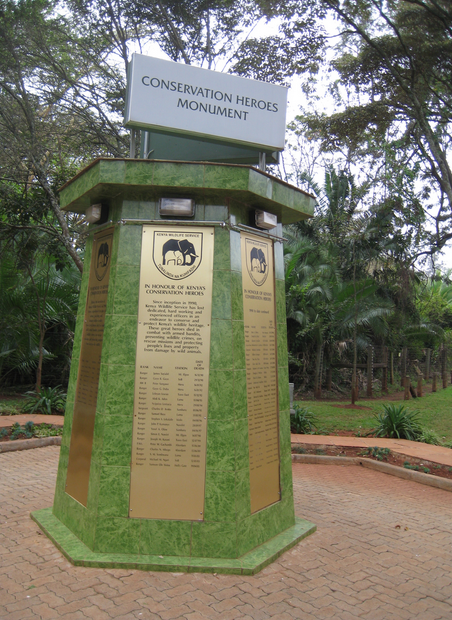
Picture above - KWS monument in honor of Kenyan Wildlife Rangers killed on active duty.
“Being a ranger was not a choice but a calling,” says Stephen Midzi, whose base is Shangoni Post in Kruger. “I was born for this, so had to fulfill what has already been written in my book of life.” Zakouma’s Ndotoingar says simply, “I’m proud of my work.” “Not a single guy has quit,” SANParks’ Jooste notes, adding that without the rangers like Midzi, poaching statistics would be a lot worse. “Look what would happen if we weren’t here.”
Every four days in Africa and around the world a ranger or Anti Poaching Operative is killed in their line of work. Many either face a quick death, are killed by contract shooters or tortured to death. The risks are endless yet wildlife security forces still risk their lives despite pittance [very little monetary income].
As explained International Animal Rescue Foundation Africa is challenging the South African government on shooting to defend of which the organisation wants a clear and precise “shoot to kill” law introduced for wildlife rangers and Anti Poachers not just SANDF. Furthermore I.A.R.F.A. calls on the government to not only authorize rangers to adopt this method of conservation but implement a NO conviction No Legal action clause within contract. Training and more equipment to be supplied to rangers too and rangers with no firearms to be equipped without delay.
International Animal Rescue Foundation Africa doesn’t stand alone either when it comes to such licence to kill policy. Over 90% of South Africans questioned agreed that a shoot to kill policy must be enforced to send a clear and precise message to poachers and king-pins that poaching will not be tolerated within the country. Should the organisation win it could see rangers in other countries authorized a licence to kill. Kenya is one such country on the continent of which KWS - [Kenyan Wildlife Service rangers] not only face death from poachers but are also heavily outnumbered by poachers that are slaughtering rhino and elephants.
The Peoples Verdict - Licence to Kill;
Back in November International Animal Rescue Foundation Africa and India started a public debate with regards to the shoot to kill policy. The debate has thus far seen quite a prolific response from which can be read below. Quite astonishingly we counted a mere dozen or more responses that were against the shoot to kill policy, whereas over 2,000 responses based from our Indian and South African debates called for a shoot to kill policy to be implemented.
Below is a handful of extracted responses for you all to read. You can join the debate by logging onto Facebook and clicking the link below. Alternatively you vote via our poll that will be the second third poll this year of which we will collect all results and begin passing these on to the government and ministries throughout Africa.
Roxanne Cochran stated - I am from South Africa. I agree fully with this notion. If they’re willing to take a life, they should be prepared to be shot down dead too. It’s very sad to see that most rhinos here have had there horns cut down for protection. It’s not natural and it breaks my heart that we have to go to such extremes to protect these beautiful creatures.
Gavin Hastings stated - Hello all, I am a serving soldier of the SANDF; I am just back from my 3rd deployment of 6 months from the Kruger. The problem id like to address is not man power or resources, it is the government of the country of South Africa and Mozambique who are now collaborating in the elimination of the species of rhino thanks to the bureaucratic impasse given to poachers of rhinos. As a soldier I am now “arresting” poachers. It is very difficult to maintain success and morale if you capture a person and he is extradited to re-do his killing the next week. I ask the international community to pressure my government. We need legislation to properly take care of the species survival and give the killers their fair due.
George Chimbai stated - In my country Malawi rhinos were once extincted and were re-introduced in the 1990s with rhinos from South Africa, without that Malawi wouldn’t have been boasting of having the BIG FIVE in its national parks and game reserves. South Africa as a supplier of endangered species to countries where they’re facing extinction I welcome and support the SHOOT TO KILL POLICY of these poachers.
Leisa Cope stated- I agree with shoot to kill only because I don’t see any other option. The consequences of killing animals not only brutally but into extinction needs to be this intense to at least make poachers think twice about what they are doing. If poachers choose to risk their lives then this is their own decision. How sad it is when it comes to this form of action.
Berdine Helderberg stated - Definitely shoot to kill - although, a warning shot might be needed first? (Legal wise..) Poachers know what they are doing, they know it is wrong and because they know they are untouchable, they continue committing these horrible horrible crimes. They simply do not care about the intense suffering of the animals and sometimes the babies too. If you can do it to a defenseless, helpless animal, you will do it to a human being too. Lastly, they will shoot any person that comes in their way, not thinking twice.
Kerryn Hay stated - Shoot to kill definitely. I have no sympathy for poachers even if they are disadvantaged/uneducated and trying to put food on table as some of you have argued - they are making the decision to brutally murder helpless animals and every action has consequences. Kill these criminals! why are we even considering giving them rights when animals have none. If it’s working in India then we must try it because nothing South Africa has done has helped thus far and time is running out while we debate the rights of ruthless criminals! I would prefer to see them die as slowly and painfully as the animals that they murder but let’s shoot to kill and make an example of them!
Heather Smith stated - These poachers are killing innocent animals, so why shouldn’t they expect the same treatment. Rangers are shooting to save these animals lives, poachers are shooting purely for money. You have my support all the way. Shoot to kill!!! Just as the poachers do.
Debbie Olivier stated - South Africa wake up! Allow our rangers to shoot to kill - no questions asked. We have entrusted our wildlife to them - we need to trust them with this too as they are well trained.
Donny De Mars stated - Why shouldn’t there be a shoot to kill law? I mean what makes you think these poachers would not do the same for any unarmed ranger who tries to bring them in. They are no better than drug traffickers and deserve even more severe punishment! A life for a life.
Robert Cates stated - I think a shoot to kill policy/law should be enacted not only to stop dead the ones doing it now, but also to SHOW/deter others thinking about doing it. I don’t think it should be even controlled by the police department… I think it should be an open season sort of policy… that should really put the scare in them.
Whoozie Blue Marlene stated - If you were running away from a bank having stolen a rare pink diamond the. The police would shoot you down dead. Are our rhinos not rare enough, aren’t they our beautiful pink diamonds?. Telling a poacher to stop or else does not work and if it does they are back in business chop chop. If this was installed it would work simply because no one wants to die. God left these animals in our care, so far the care has not been good enough I’m afraid. Protect our Rhino please because enough is enough !!
James Kipterem stated - I agree! Because rangers too are being targeted by these evil minded poachers. Even poachers, they have the same thought of “shoot to kill” whenever they meet rangers. So shoot to kill is the only remedy to a poacher, because, why break the law which we were passing together? that, ‘it is illegal to kill wild animals’. Instead of defending the law you break it. That is very bad. Always law defenders are more than breakers.
Jannette Slabbert stated - Any bad behavior must have real and costly consequences or you will never change it prison is obviously not enough of a penalty so if loosing your life is the price then so be it. It has proven effective in India then I say put the policy in SA too.
Russell Gordon stated - Future generation will blame us for not doing enough to have prevented the total extinction of the Rhino. So to address this now to preserve the Rhino for our future generations poachers and their ring leaders need to feel pain and by that I mean the ultimate sentence, the death penalty.
Laurian Knop stated - I vote shoot to kill poachers in self defense. Poachers are always armed and chose to kill the helpless and innocent. How many rangers have lost their lives to poachers? Self defense is not murder. Protecting those unable to defend themselves is not a criminal offense. Poachers are a scourge that need to be wiped out as they facilitate a bigger epidemic of terrorism, trafficking of drugs and children and general corruption. Why is this even being second-guessed? Do those opposed have something to lose should it be implemented?
Chris Switzer stated - I believe the continuity of a species, far outweighs any issues that might be brought up with regard to a shoot to kill policy. Poaching an endangered species, many of which on the brink of extinction, should be punishable by death.
Annmarie Botelho stated - I think that south Africa should have shoot to kill laws… if it keeps going the way it is we are going to lose are elephants and rhino …. it’s such a cruel trade and there really isn’t any need for it.
Gillian Curley stated - I don’t like the shoot to kill as the poachers are just doing what they are told to do and feed their families BUT something has to be done and if we can’t get the leaders and the buyers then yes sadly I agree to shoot to kill.
Marisol Davila stated - A policy of shoot to kill poachers will be a deterrent for the poaching business. Due to lax policies wildlife numbers are in the brink of extinction. Many economies depend on the tourism that wildlife attracts. Therefore, a harsh policy against poachers and their customers is key if any country wants to strengthen it’s economic survival in the long run. The message need to be loud and clear zero tolerance to poaching, no bits or ifs allow.
To take part in the debate that International Animal Rescue Foundation Africa is running you can comment by clicking here alternatively you can also hit the poll button below and tell us what you want. Please be aware that the poll expires one week from the date of this article of which we will not run another poll.
BEFORE voting please view the video below.
Conclusion;
International Animal Rescue Foundation Africa last year created data models that indicated their worst fears regarding wildlife poaching based on poaching deaths, natural deaths, gestation, deaths of unborn fetus, decreased populations of other larger fauna such as elephants and more. Model data has already shown that South Africa’s poaching rate will continue to increase and has provided very worrying numbers of final statistics supported by defense organisations working hard to stem the flow of poaching.
While none of us wants to see, read or hear of any living creature death - We must send a more stronger and decisive message into Asia and African poaching communities, and while tackling poaching is one thing we’ve also poverty to engage that will take the temptation away from individual opportunistic poachers that kill to fend for their families. Its these very communities that Asian traffickers and king-pins target as they know they are easy prey.
Look at it simply like this. If your living with no food, no electricity, no sanitation and require health support, are barely feeding your family or even yourself and living within a country that is doing little to decrease poverty then you will snap the chance up at anyone given moment to make money. Conservation organisations and leaders of Africa and world leaders must do more to decrease poverty around wildlife parks.
Failing this Data Models have shown that the white rhino will be verging near endangerment by 2017 of which the black rhino could be extinct in under five years within the wild [despite populations increasing]. Furthermore while the continent of Africa is still custodian to thousands of elephants, elephant populations are becoming more fragmented. Yesterday I.A.R.F.A reported a massive decline in South Sudan elephant populations that now stand at some 2,500. Giraffe populations are now at some 40,000 for the entire continent of Africa.
Bottom line is should Africa lose vast swathes of her wildlife then tourism will be affected too. Tourism brings in billions for the entire continent of Africa of which Africa’s wildlife is seen as the number one tourist attraction. A large number of countries depend on tourism for the economic growth. A recent study done for DFID concluded: “While poor countries only command a minority share of the international tourism market, tourism can make a significant contribution to their economies.
Eighty percent of the world’s poor (below US$1 a day) live in 12 countries. In 11 of these, tourism is significant and/or growing. Of the 100 or so poorest countries, tourism is significant (accounting for over 2% of GDP or 5% of exports) in almost half the low income countries and almost all the lower-middle income countries.” Using these same criteria and 1996 data, tourism is “significant” in an impressive number of African countries: Benin, Botswana, Burkina Faso, Cape Verde, Comoros, Djibouti, Eritrea, Ethiopia, Gambia, Ghana, Kenya, Madagascar, Mauritius, Namibia, Niger, Senegal, Sao Tome & Principe, Seychelles, Sierra Leone, South Africa, Swaziland, Tanzania, Togo, Uganda, Zimbabwe. Zambia and Mali just missed the cutoff in 1996.
According to the World Tourism Organization (WTO), Africa as a whole attracts just fewer than 4% of total world tourists and accounted for 2.0% of international tourism receipts in 1997. Of the Sub-Saharan countries, only South Africa is listed in the top forty tourism destinations worldwide, where it was 26th in 1997. The WTO calculated [1996] that Africa had just over 3% of world accommodation capacity (796,000 beds). The Africa region showed the strongest expansion in arrivals of any world region in 1997, up 8.1% over 1996. Furthermore, during the 1988-97 decade, Africa had an average annual growth of 7.2% in visitor arrivals, only slightly lower than East Asia/Pacific, which had the highest growth rate of all regions though from a much higher base than Africa. The average annual growth rate for tourist arrivals worldwide has averaged 5.0% for the past decade.
However - the number of tourists now arriving in SSA has grown over 300% since 1990, with 2012 marking a high of 33.8 million tourists who visited the region. Income generated from tourism has also climbed: Receipts from hotels, tours and other attractions in 2012 amounted to over US$36 billion and directly contributed just over 2.8% to the region’s GDP, according to the report issued by the World Bank back in 2013.
Wild animals are probably one of the first things people think of when asked about Africa. Seeing all the documentaries on television, we can only wonder and watch in awe as these mighty creatures roam the plains and jungles. Many are now protected in reserves and tourists can venture out on varying safaris to watch them in their nature habitats. What an incredible experience for both the amateur and professional photographer! Zambia holds the most natural of parks because the area is not accessible between November and March due to the waterways. Since the animals, plants, birds, and other natural elements are left alone, the area is truly spectacular when viewed each year after this rejuvenation period.
Safari rates as number four on many tour guide questionnaires when asking tourists why they wish to visit Africa. So in all if we continue to see such a vast decline in wildlife and lack of hard core enforcement we’ll most certainly see a copious decline in tourism revenue. I don’t need to explain what that will spell either.
International Animal Rescue Foundation has been challenged by only Humans Rights Christian Organisation of which stated we should not lobby or enforce a licence to kill poachers. All that can be said to the Human Rights players is that when there are no animals left, and revenue is seen as shrinking because of this then the Human Rights organisations can visit Africa and tackle more violent crime, lack of any employment, rape, murder, and more.
The time to act is now and not tomorrow. Stand by International Animal Rescue Foundation and help us enforce a shoot to kill policy within South Africa, Kenya and Tanzania.
Thanks
Board of Directors for External Affairs - Ead
Chief Executive Officer of Environmental Projects Africa - Michael L. Rooste
Chief Environmental Officer & CEO Dr Jose C Depre
Chief Environmental Registrar Europa - J. F. Williamson
External Affairs and Lead Investigation Officer - Vincent Van der spuy
You can help us by donating, to donate click the picture below that will take you to our donation application on Facebook. Alternatively you can donate to our communications site listed hereto at
www.international-animalrescue-foundation.org.uk
